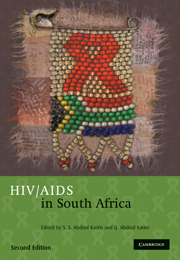Book contents
- Frontmatter
- Contents
- List of Contributors
- Foreword: Peter Piot
- Foreword: Nelson R Mandela
- Acknowledgements
- Section 1 Birth of a rapidly growing epidemic
- Section 2 The virus, the human host and their interactions
- 5 Viral structure, replication, tropism, pathogenesis and natural history
- 6 HIV diagnostics
- 7 HIV-1 genetic diversity
- 8 Cellular immunity in HIV: a synthesis of responses to preserve self
- Section 3 HIV risk factors and prevention strategiess
- Section 4 Focal groups for understanding the HIV epidemic
- Section 5 The impact of AIDS
- Section 6 Treating HIV
- Section 7 What does the future hold?
- Index
6 - HIV diagnostics
Published online by Cambridge University Press: 07 September 2011
- Frontmatter
- Contents
- List of Contributors
- Foreword: Peter Piot
- Foreword: Nelson R Mandela
- Acknowledgements
- Section 1 Birth of a rapidly growing epidemic
- Section 2 The virus, the human host and their interactions
- 5 Viral structure, replication, tropism, pathogenesis and natural history
- 6 HIV diagnostics
- 7 HIV-1 genetic diversity
- 8 Cellular immunity in HIV: a synthesis of responses to preserve self
- Section 3 HIV risk factors and prevention strategiess
- Section 4 Focal groups for understanding the HIV epidemic
- Section 5 The impact of AIDS
- Section 6 Treating HIV
- Section 7 What does the future hold?
- Index
Summary
KNOWLEDGE OF HIV STATUS is important in efforts to mitigate the effects of the disease, hence the interest in testing and diagnosis. The most common screening tests for HIV are the ELISAs and Simple Rapid Assays. Assays that can use alternative body fluids such as saliva, whole blood and urine are also being developed. The choice of diagnostic test depends to some extent on the clinical stage of HIV infection because of the complexity of the infection process.
There are two approaches to the diagnosis of hiv – the detection of the virus itself and detection of an immunological response to the virus through the production of antibodies or cellular responses. More recently, rapid testing is widely used and a novel advance is confirmatory rapid testing that contains multiple antigens. These tests are useful in clinic settings where sophisticated technology is not available and personnel may not be fully trained in other techniques.
The choice of diagnostic testing is determined by the diagnostic setting, e.g. early diagnosis relies on viral antigens, blood for transfusion on nucleic acid or antibody and antigen testing and occupational exposure on baseline antibody testing and proviral dna.
Population serosurveillance requires different approaches to testing, depending on predicted population prevalence. An hiv test should be considered positive only after screening and confirmatory tests are reactive. False-positives when both these tests are positive are rare.
- Type
- Chapter
- Information
- HIV/AIDS in South Africa , pp. 97 - 116Publisher: Cambridge University PressPrint publication year: 2010

